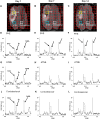Serial Metabolic Evaluation of Perihematomal Tissues in the Intracerebral Hemorrhage Pig Model
- PMID: 31496934
- PMCID: PMC6712426
- DOI: 10.3389/fnins.2019.00888
Serial Metabolic Evaluation of Perihematomal Tissues in the Intracerebral Hemorrhage Pig Model
Abstract
Purpose: Perihematomal edema (PHE) occurs in patients with intracerebral hemorrhage (ICH) and is often used as surrogate of secondary brain injury. PHE resolves over time, but little is known about the functional integrity of the tissues that recover from edema. In a pig ICH model, we aimed to assess metabolic integrity of perihematoma tissues by using non-invasive magnetic resonance spectroscopy (MRS).
Materials and methods: Fourteen male Yorkshire pigs with an average age of 8 weeks were intracerebrally injected with autologous blood to produce ICH. Proton MRS data were obtained at 1, 7, and 14 days after ICH using a whole-body 3.0T MRI system. Point-resolved spectroscopy (PRESS)-localized 2D chemical shift imaging (CSI) was acquired. The concentration of N-Acetylaspartate (NAA), Choline (Cho), and Creatine (Cr) were measured within the area of PHE, tissues adjacent to the injury with no or negligible edema (ATNE), and contralesional brain tissue. A linear mixed model was used to analyze the evolution of metabolites in perihematomal tissues, with p-value < 0.05 indicating statistical significance.
Results: The perihematoma volume gradually decreased from 2.38 ± 1.23 ml to 0.41 ± 0.780 ml (p < 0.001) over 2 weeks. Significant (p < 0.001) reductions in NAA, Cr, and Cho concentrations were found in the PHE and ATNE regions compared to the contralesional hemisphere at day 1 and 7 after ICH. All three metabolites were significantly (p < 0.001) restored in the PHE tissue on day 14, but remained persistently low in the ATNE area, and unaltered in the contralesional voxel.
Conclusion: This study highlights the potential of MRS to probe salvageable tissues within the perihematoma in the sub-acute phase of ICH. Altered metabolites within the PHE and ATNE regions in addition to edema and hematoma volumes were explored as possible markers for tissue recovery. Perihematomal tissue with PHE demonstrated a more reversible injury compared to the tissue adjacent to the injury without edema, suggesting a potentially beneficial role of edema.
Keywords: intracerebral hemorrhage; magnetic resonance spectroscopy; perihematomal edema; pig ICH model; serial neuroimaging study.
Figures



Similar articles
-
Molecular, Pathological, Clinical, and Therapeutic Aspects of Perihematomal Edema in Different Stages of Intracerebral Hemorrhage.Oxid Med Cell Longev. 2022 Sep 17;2022:3948921. doi: 10.1155/2022/3948921. eCollection 2022. Oxid Med Cell Longev. 2022. PMID: 36164392 Free PMC article. Review.
-
Longitudinal, Quantitative, Multimodal MRI Evaluation of Patients With Intracerebral Hemorrhage Over the First Year.Front Neurol. 2021 Nov 30;12:764718. doi: 10.3389/fneur.2021.764718. eCollection 2021. Front Neurol. 2021. PMID: 34917017 Free PMC article.
-
Sex differences in perihematomal edema volume and outcome after intracerebral hemorrhage.medRxiv [Preprint]. 2023 Sep 29:2023.09.28.23296302. doi: 10.1101/2023.09.28.23296302. medRxiv. 2023. Update in: Neurocrit Care. 2024 Aug;41(1):208-217. doi: 10.1007/s12028-024-01945-z. PMID: 37808630 Free PMC article. Updated. Preprint.
-
Clinical implications of Peri-hematomal edema microperfusion fraction in intracerebral hemorrhage intravoxel incoherent motion imaging - A pilot study.J Stroke Cerebrovasc Dis. 2023 Nov;32(11):107375. doi: 10.1016/j.jstrokecerebrovasdis.2023.107375. Epub 2023 Sep 20. J Stroke Cerebrovasc Dis. 2023. PMID: 37738914 Free PMC article.
-
Perihematomal edema: Implications for intracerebral hemorrhage research and therapeutic advances.J Neurosci Res. 2020 Jan;98(1):212-218. doi: 10.1002/jnr.24372. Epub 2018 Dec 21. J Neurosci Res. 2020. PMID: 30575082 Free PMC article. Review.
Cited by
-
Molecular, Pathological, Clinical, and Therapeutic Aspects of Perihematomal Edema in Different Stages of Intracerebral Hemorrhage.Oxid Med Cell Longev. 2022 Sep 17;2022:3948921. doi: 10.1155/2022/3948921. eCollection 2022. Oxid Med Cell Longev. 2022. PMID: 36164392 Free PMC article. Review.
-
Dl-3-n-Butylphthalide promotes neovascularization and neurological recovery in a rat model of intracerebral hemorrhage.BMC Neurosci. 2020 May 29;21(1):24. doi: 10.1186/s12868-020-00575-3. BMC Neurosci. 2020. PMID: 32471341 Free PMC article.
-
Perihematomal Edema After Intracerebral Hemorrhage: An Update on Pathogenesis, Risk Factors, and Therapeutic Advances.Front Immunol. 2021 Oct 19;12:740632. doi: 10.3389/fimmu.2021.740632. eCollection 2021. Front Immunol. 2021. PMID: 34737745 Free PMC article. Review.
-
Relevance of Porcine Stroke Models to Bridge the Gap from Pre-Clinical Findings to Clinical Implementation.Int J Mol Sci. 2020 Sep 8;21(18):6568. doi: 10.3390/ijms21186568. Int J Mol Sci. 2020. PMID: 32911769 Free PMC article. Review.
-
Changes in Cerebral Blood Flow and Diffusion-Weighted Imaging Lesions After Intracerebral Hemorrhage.Transl Stroke Res. 2022 Oct;13(5):686-706. doi: 10.1007/s12975-022-00998-6. Epub 2022 Mar 19. Transl Stroke Res. 2022. PMID: 35305264 Review.
References
-
- Al-Shahi Salman R., Frantzias J., Lee R. J., Lyden P. D., Battey T. W. K., Ayres A. M., et al. (2018). Absolute risk and predictors of the growth of acute spontaneous intracerebral haemorrhage: a systematic review and meta-analysis of individual patient data. Lancet Neurol. 17 885–894. 10.1016/S1474-4422(18)30253-9 - DOI - PMC - PubMed
Grants and funding
LinkOut - more resources
Full Text Sources

